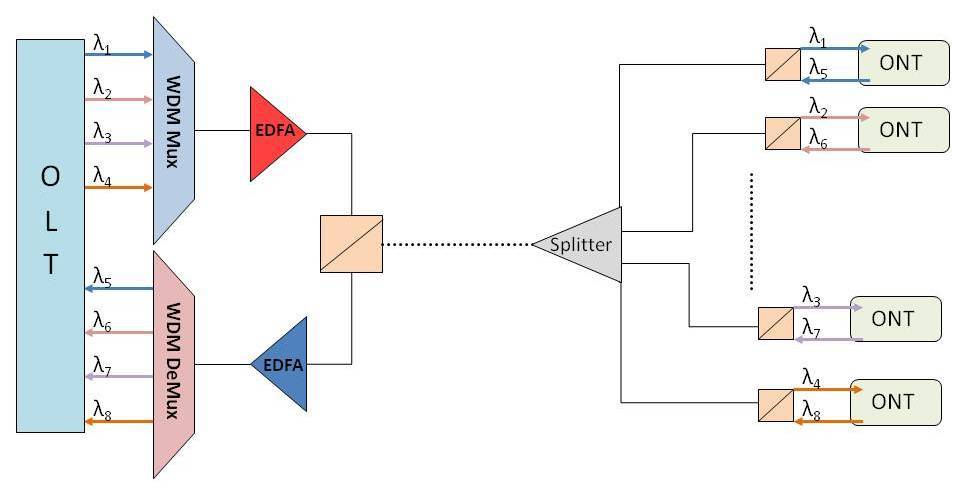PON Networks Next Step

On duty, I have to somehow track the news on fiber-optic topics. And once again, asking for interesting news, I realized that in the Russian-speaking segment of the Internet there is almost no information about new technologies. Therefore, in my article I would like to talk about the young TWDM PON technology and, as a result, about the upcoming tight integration of passive networks with the WDM component and tunable optical components.
PON technology today is the most promising for the provision of telecommunications services to individuals, legal entities - in this case we can talk about small and medium businesses, as well as in the framework of the organization of the last mile for mobile operators. Due to the wide range of applications of passive optical networks when creating Next-gen PON, the main emphasis was placed on a higher transmission capacity of the transmission network.
There are two main directions of development of PON - EPON-network and GPON-network.
')

The last step in the evolution of GPON-networks is the technology TWDM PON - Time Wavelength Division Multiplexing Passive Optical Networking, passive optical networks with time and frequency (spectral) multiplexing.
The TWDM-PON technology uses four pairs of wavelengths in different spectral ranges to organize duplex communication channels. For the formation of upstream streams, wavelengths (λ1 - λ4) are used, for downstream (λ5 - λ8).
In TWDM PON systems, three frequency ranges can be used for transmitting streams: 1270-1280 / 1570-1580 nm - XG-PON-range, 1535-1540 / 1553-1558 nm - C-band-band, 1535-1540 / 1570- 1580nm - + L-band-range.
The transmission of TWDM PON signals in the C-band and C + L-band ranges allows the use of EDFA optical amplifiers to increase the optical budget of the track.

In addition to the larger number of wavelengths used to form up / downstream streams, TWDM PON involves the use of tunable optical transmitters (tunable Tx) and selective optical receivers (selective Rx) in the station and terminal equipment (OLT and ONU / ONT).
The use of tunable components allows you to scale, rebuild the TWDM PON network at the hardware level without the need to physically rebuild the transmission network.
TWDM PON allows, in addition to the flexible tuning of the waves, to fine-tune the transmission rate within one channel. Both 10G / 10G and 2.5G / 2.5G as well as unbalanced 10G / 2.5G communication channels are supported.
TWDM PON networks use wavelength ranges - XG-PON range, C-band range and C + L-band range.
1. XG-PON range. The frequency plan completely repeats the XG-PON operating ranges: 1270-1280 nm for upstream and 1570-1580 nm for downstream. The use of this frequency plan allows you to organize the transfer within one network: TWDM PON, GPON, CATV.

It is impossible to use EDFA optical amplifiers in this frequency grid; therefore, the maximum optical budget of the system is 33 dB.
The use of XG-PON-range is justified, if necessary, to embed new transmission channels into the existing GPON + CATV system without the need to increase the optical budget of the track.
2. C-band. In this case, the frequency plan is a standard C-band: 1535-1540 nm for upstream and 1553-1558 nm for downstream. The use of such a frequency plan allows you to organize the transfer within one network: TWDM PON, GPON, XG-PON.

Due to the use of C-band wavelengths, it is possible to use standard EDFA optical amplifiers for DWDM networks with an operating range of 1529-1561 nm. Using EDFA allows you to increase the maximum optical budget of the system to a value of 38 dB. Optical amplifiers are installed on the side of the head station, which allows not to change the existing network architecture and not to introduce additional volatile elements into the passive network.
The downside to using this frequency plan is its incompatibility with the existing CATV network.
3. C + L-band. This frequency plan involves the use of the Red-band or C-minus Band 1535-1540 nm for the upstream and L-minus Band 1570-1580 nm for the downstream. The use of this frequency plan allows you to organize the transfer within one network: TWDM PON, GPON, CATV.

Using this frequency plan allows you to rely on the optical budget of up to 38 dB and the simultaneous transmission of PON and CATV signals. However, the TWDM PON system in the C + L-band range has its own characteristics, the main one being the need to use L-band amplifiers for downstream. At the moment, the EDFA L-band range is of little demand, since the C-band fully meets the needs of the telecommunications market.
If we compare existing GPON systems with TWDM PON technology, such as GPON and XG PON1, then we can distinguish at least three distinctive features for which TWDM technology is more promising:
Total system bandwidth. For GPON systems, the bandwidth is 10 Gb / s downstream and 2.5 Gb / s upstream, while the TWDM PON bandwidth is four independent streams of 10 Gb / s each, which determines the total system bandwidth of 40 Gb / s. .
Frequency range. GPON systems use two wavelengths to form a link. It should be noted that sufficiently wideband signals λ1 ± 5 nm are used. At that time, TWDM PON systems use four pairs of wavelengths with a rather narrow spectrum λ1 ± 1.6 nm. It should also be noted that in the future the number of involved wavelengths is planned to increase to eight.
Optical budget. Due to the impossibility of using optical amplifiers for GPON systems, the optical budget is limited to <30 ~ 33 dB, in contrast to TWDM PON systems, for which the optical budget reaches 38 dB.
Based on the above distinctive features of TWDM PON, we can assume two main scenarios for the use of such systems in practice:
The first scenario is pay-as-you-grow. This scenario involves the gradual introduction of TWDM PON technology as part of the expansion of an existing network or at the stage of deployment of a new one.
The number of pairs of wavelengths involved (duplex communication channels) directly depends on the number of network subscribers, while increasing the latter, the operator can introduce new AP channels into operation without a global construction of fiber optic links. The operator eliminates the need to initially “pledge for the future”, it becomes possible to systematically invest in the development of the network, which significantly reduces financial risks and also minimizes errors in the network development strategy.
The second use case for TWDM PON systems is “local-loop-unbundling” (LLU). This scenario involves the sharing of a single PON network by several operators or the intentional fragmentation of the network of a single provider. In the LLU scenario, a certain pair of wavelengths is used for each provider / optical subnetwork. Such a scenario will reduce the financial costs for a group of operators when building a PON network or increase the resiliency of a network of one operator.
The prospects for the development of TWDM PON technology are quite impressive, since the use of optical amplifiers, tunable optical components, allows operators to maximize the flexibility to deploy and develop passive optical networks. Accordingly, the operators themselves can choose the network development scenario that best suits their business model. TWDM PON can coexist with other PON technologies, it also leaves room for operator growth and adding wavelengths gradually, as needed. As a result, the operator can build a network, run GPON, and then allocate wavelengths for provider companies or leave them for their own needs.
Source: https://habr.com/ru/post/398101/
All Articles